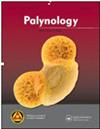Making a Long Continental Pollen Record, a Fabulous and Bizarre Enterprise: A 50-year Retrospective
IF 1.3
4区 地球科学
Q3 PALEONTOLOGY
引用次数: 0
Abstract
Long continental pollen records (LCPRs) form a remarkable aspect of palynological research. They are rare, mostly collected in multiple coring sessions, due to time constraints they often do not reach the sample resolution anticipated, train the international audience to accept regularly improved age models, and show exciting histories of how ecosystems responded to Quaternary ice-age cycles. LCPRs also offer marine, and icecore studies a framework to explore how marine, ice and land ecosystems are responding to climate change in a mutual interaction. The decennia needed to complete such record is bizarre resulting in pollen records do not match in time with fast results from proxies with automatized procedures. Unfortunately, the development of long pollen records is in practice restricted to palynologists with a long research horizon. New applications of LCPRs have been explored in mountain areas. Sample-resolution steps through the last million years show how the surface of north Andean high mountain vegetation (p aramo) dramatically and repeatedly changed in surface, hinting at evolutionary processes.制作大陆花粉长记录,一项神奇而奇特的事业:50年回顾
长期大陆花粉记录(LCPRs)是孢粉学研究的一个重要方面。它们很罕见,大多是在多次取芯过程中收集的,由于时间限制,它们往往达不到预期的样本分辨率,训练国际观众接受定期改进的年龄模型,并展示了生态系统如何应对第四纪冰河周期的激动人心的历史。LCPR还为海洋和冰芯研究提供了一个框架,以探索海洋、冰和陆地生态系统如何在相互作用中应对气候变化。完成这样的记录所需的decenia是奇怪的,导致花粉记录在时间上与自动化程序的代理的快速结果不匹配。遗憾的是,长期花粉记录的发展在实践中仅限于具有长期研究视野的花粉学家。LCPR在山区的新应用已得到探索。过去一百万年中的样本分辨率步骤显示了安第斯山脉北部高山植被(p aramo)的表面是如何急剧而反复地变化的,这暗示了进化过程。
本文章由计算机程序翻译,如有差异,请以英文原文为准。
求助全文
约1分钟内获得全文
求助全文
来源期刊

Palynology
地学-古生物学
CiteScore
3.40
自引率
26.70%
发文量
48
审稿时长
>12 weeks
期刊介绍:
Palynology is an international journal, and covers all aspects of the science. We accept papers on both pre-Quaternary and Quaternary palynology and palaeobotany. Contributions on novel uses of palynology, review articles, book reviews, taxonomic studies and papers on methodology are all actively encouraged.
 求助内容:
求助内容: 应助结果提醒方式:
应助结果提醒方式:


